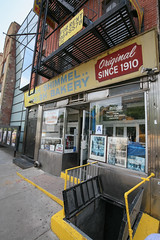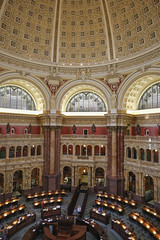Trevis Rothwell's weblog
Nixon Now
6 November 2018
 I was recently at the Richard M. Nixon Presidential Library and Museum in Yorba Linda. Having never before taken the time to learn much about Nixon, my impression of him, molded by superficial academia and mass media, was that he was corrupt, disgraced, and most definitely a “crook”.
I was recently at the Richard M. Nixon Presidential Library and Museum in Yorba Linda. Having never before taken the time to learn much about Nixon, my impression of him, molded by superficial academia and mass media, was that he was corrupt, disgraced, and most definitely a “crook”.
Perusing the exhibits, I learned for the first time about what might have been one of the best presidents in United States history. His accomplishments both within the country and in relations with other countries are numerous and impressive. Why has his reputation been watered down to Watergate? Even there, it seems that what actually happened is not be as bad as what the general public has been led to believe. Nixon himself offered in 1978:
Some people say I didn’t handle it properly and they’re right. I screwed it up. Mea culpa. But let’s get on to my achievements. You’ll be here in the year 2000 and we’ll see how I’m regarded then.
Now in 2018… it seems that he remains best-known for Watergate.
He also had some amazing campaign songs:
Thanks to the great exhibition displays at the museum, I look forward to learning more about our 37th president. Happy Election Day!
The Greatest Love
28 October 2018
 At our 2008 wedding, Jennifer and I had my cousin Hannah McDonald sing the Harlan Rogers composition The Greatest Love (with lyrics later added by Phil Driscoll). In celebration of our ten-year anniversary, we at Atmosphere Control Productions have published a single of this song, retaining the original drum track from the wedding (courtesy of Carl Albrecht), along with updated keys, guitars, bass, and vocal tracks. Available as a digital download now from iTunes, Amazon Music, CDBaby, etc. Buy a copy today! Better yet, buy a thousand!
At our 2008 wedding, Jennifer and I had my cousin Hannah McDonald sing the Harlan Rogers composition The Greatest Love (with lyrics later added by Phil Driscoll). In celebration of our ten-year anniversary, we at Atmosphere Control Productions have published a single of this song, retaining the original drum track from the wedding (courtesy of Carl Albrecht), along with updated keys, guitars, bass, and vocal tracks. Available as a digital download now from iTunes, Amazon Music, CDBaby, etc. Buy a copy today! Better yet, buy a thousand!
And Happy 10-Year Anniversary to Jennifer! I love you very much!
See also: original instrumental version from 1986 by Harlan Rogers with Koinonia
Lower East Side Memories
1 October 2018
 A little bit late, but Happy New Year! I just finished reading Hasia Diner’s book Lower East Side Memories: A Jewish Place In America. For several decades around the end of the 19th century and beginning of the 20th, many Jewish people from immigrated from Europe to the United States, with many of those living either temporarily or permanently in a Manhattan neighborhood subsequently known as the Lower East Side. Not all of the Jewish immigrants lived in the Lower East Side, and not all of the Lower East Side immigrant residents were Jewish at all. But that particular subset of immigrants created a culture in that neighborhood which formed a primary basis for Jewish culture throughout the country.
A little bit late, but Happy New Year! I just finished reading Hasia Diner’s book Lower East Side Memories: A Jewish Place In America. For several decades around the end of the 19th century and beginning of the 20th, many Jewish people from immigrated from Europe to the United States, with many of those living either temporarily or permanently in a Manhattan neighborhood subsequently known as the Lower East Side. Not all of the Jewish immigrants lived in the Lower East Side, and not all of the Lower East Side immigrant residents were Jewish at all. But that particular subset of immigrants created a culture in that neighborhood which formed a primary basis for Jewish culture throughout the country.
Many Jewish immigrants ended up in Boston, and in Chicago, and in St. Louis, and in Los Angeles, and in other cities across the country, and even in other parts of New York City. But a clear majority ended up staying in the Lower East Side, filling cramped apartments with so many people that Jewish culture flourished, and was easily found not just in the privacy of individual homes, but openly on the streets, in shops, in restaurants… And with such overcrowded housing, there was little privacy anyway, leading to characteristically private conversations happening in larger groups, spreading and sharing cultural ideas even further.
In this atmosphere of open exchange, many artifacts of historical and cultural record were created. Factual accounts were written. Journalistic photographs were taken. Novels and plays and poems and songs were authored, all in much greater abundance than what happened in other Jewish communities.
That wealth of history about, and emanating from, the Lower East Side surely would have been significant in its own right, but after the 1940s it became even more significant. Through the Holocaust events of World War II, huge amounts of European Jewish culture and history were destroyed. Many people were killed, yes, but on top of that, houses and businesses and religious institutions were wiped out. Italian immigrants still had Italy. Irish immigrants still had Ireland. But the Jewish people who had left their “old world” homeland for the “new world” in the United States no longer had an “old world” to correspond with or to ever return to, even for a visit.
As such, the Lower East Side took on a new level of importance in Jewish-American culture: it became their new “old world”. Whether if they ever actually lived there or not, through historical accounts and stories and other media created in or about the neighborhood, Jewish people all over the country began to see it as a common ancestral home. They started to travel to the neighborhood, take tours, sample food, and learn more about what “real” Jewish-American life was like.
More: read the book.
Sherwin Williams Porch and Floor Enamel vs. Border Collie
15 July 2018
 Samantha the border collie was easily house trained, and remained so for five years in our previous house. The current house has a basement utility room with an unfinished cement floor, and Samantha apparently decided that relieving herself on the cement floor was acceptable. Of all of the floors in the house, I agree with her choice, but after two years of this, I wanted something easier to clean up than unfinished, porous cement.
Samantha the border collie was easily house trained, and remained so for five years in our previous house. The current house has a basement utility room with an unfinished cement floor, and Samantha apparently decided that relieving herself on the cement floor was acceptable. Of all of the floors in the house, I agree with her choice, but after two years of this, I wanted something easier to clean up than unfinished, porous cement.
Ceramic tile, vinyl tile, and laminate flooring were all reasonable choices for a basement utility room, but I really didn’t want to go to that extent if not necessary. I’ve seen basement floors that were painted, and seemed pretty resistant to spilled liquid, so I trundled down to the home improvement superstore and bought a can of Rustoleum concrete paint.
I painted a small test area, let it dry, and then went through the motions of cleaning it with a wet paper towel. The paint rubbed off the cement floor onto the paper towel; clearly this was not going to be a good solution to the problem!
[Did I etch the cement floor prior to painting? No. Had I etched it, would the paint have adhered better? Maybe, maybe not. It seemed pretty resistant to scraping, and to scrubbing with dry paper towels. Only with wet paper towels did any significant paint come up off the floor. I am guessing that etching would not have made a big difference here, as the paint was just too water-soluble for what I needed.]
So I went over to the local Sherwin Williams paint shop, hoping that their staff of paint specialists could offer a better solution. The employee I talked to also had a dog, and recommended their porch and floor enamel paint. He showed me an area of floor in their storage room where they themselves had applied this paint, and it appeared durable. I bought a gallon.
Back home, another spot test came back with good results: the paint seemed to stay adhered well when cleaned, so I cleared and cleaned the utility room floor and painted away. For two days, Samantha did not relieve herself at all in the house. Excellent! But I was still curious how the paint would hold up to a more intense scenario. The next day, a thunderstorm rolled through, and a certain anxious border collie relieved herself multiple times on the painted floor.
Clean up from the comparatively smooth, non-porous surface was trivial. Damp spots from the cleaning solution remained, but within a few minutes the floor looked as if nothing had happened. A tiny bit of paint appeared to come up on the paper towel, but may have been some tiny clumps of paint left from my not-completely-smooth painting job. In any event, this paint is much more durable than my first choice, and even if an occasional touch-up is needed, no big deal.
The floor looks nicer and is much easier to clean, offering daily time savings. Thank you Sherwin Williams!
[Note to self for future touch-ups: color selected was Pewter Cast (SW 7673).]
Photography Rules Around the National Mall
12 June 2018
 The last time I was at the National Archives building in Washington, D.C., I took a mediocre photograph of the very dimly-lit Declaration of Independence on ISO 400 film. A couple of weeks ago I was back, armed with much higher ISO on a Canon 6D digital camera and lens with image stabilization.
The last time I was at the National Archives building in Washington, D.C., I took a mediocre photograph of the very dimly-lit Declaration of Independence on ISO 400 film. A couple of weeks ago I was back, armed with much higher ISO on a Canon 6D digital camera and lens with image stabilization.
To my dismay, the National Archives no longer permits photography of any of their exhibits. They used to allow photography without flash, as flash could promote deterioration of their rare artifacts, but too many people ignored the no-flash rule, either intentionally or unintentionally, and they have now banned photography altogether.
How strict are they about this? I witnessed a guard pounce on a tourist with a mobile phone camera sneaking a picture of the Archives’ copy of the Magna Carta:
“No photography!”
“I’m sorry.”
“You can delete that picture.”
Of course, deleting the picture after the fact doesn’t solve anything regarding artifact deterioration…
Meanwhile, in the third-floor observation deck overlooking the main reading room of the Library of Congress, where photography used to be banned, flash-free photography is now allowed. Sitting inside the reading room, waiting for books to be delivered, I couldn’t help but notice some flashes going off, and it was indeed kind of distracting, but the library didn’t seem as intense about enforcing their newly-loosened rules as the National Archives was about enforcing their increasingly strict rules.
Speaking of rules, I would not have thought that these words would have ever had to be spoken, by a National Archives guard, to a child next to me: “Excuse me, there’s no sitting on the Declaration!”